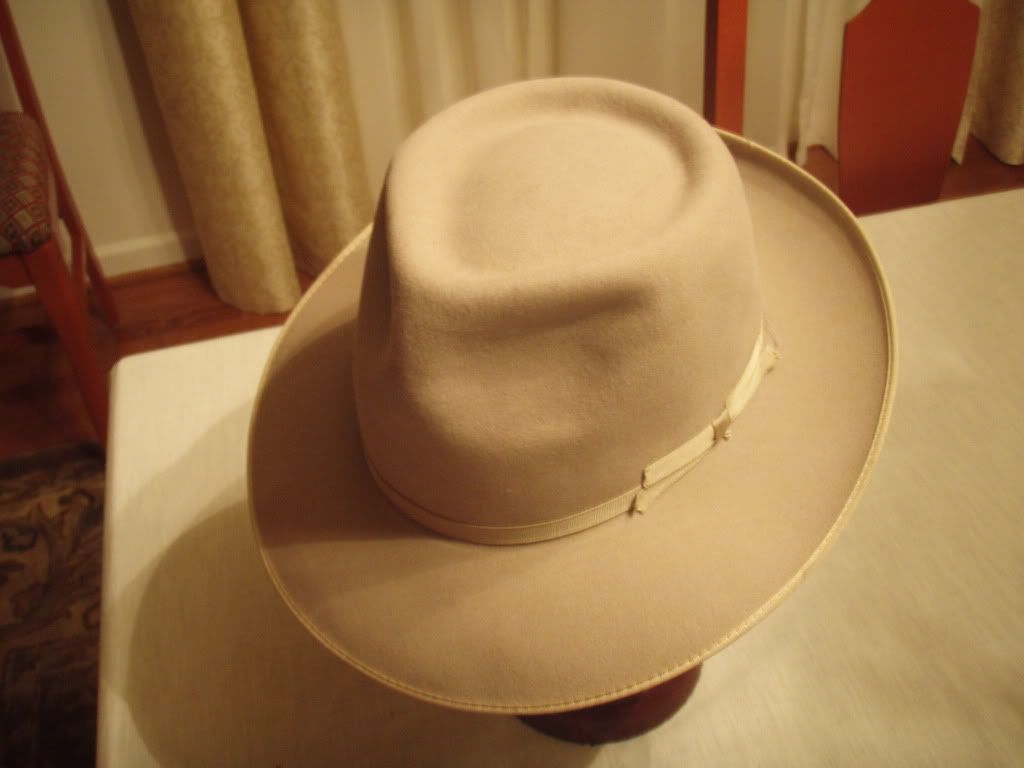- Messages
- 11,579
- Location
- Covina, Califonia 91722
Just heed all warnings of this stuff being highly flammable and the fumes being bad for your health. B
Not the best time for a cigar.
Just heed all warnings of this stuff being highly flammable and the fumes being bad for your health. B
Just heed all warnings of this stuff being highly flammable and the fumes being bad for your health.
B
I was curious if you did this naptha bath to a new Stetson Open Road would it soften the felt? I prefer the softer felt of the old Stetsons and was trying to find a way to remove the stiffener put in the newer hats. Thanks for your help.
I prefer the softer felt of the old Stetsons and was trying to find a way to remove the stiffener put in the newer hats. Thanks for your help.
I think that denatured alcohol may work. But please do continue your research before trying it. You may have to strip down the hat to the felt body before soaking, etc. Either way, do a Lounge search on denatured alcohol and see what comes up.
I have sprayed a stiff felt hat with denatured alcohol in the past and it seem to soften it up some.I think that denatured alcohol may work. But please do continue your research before trying it. You may have to strip down the hat to the felt body before soaking, etc.
Either way, do a Lounge search on denatured alcohol and see what comes up.
Did you dilute it any? I have a Resistol western conversion that I'd like to soften the brim up a might. TIAI have sprayed a stiff felt hat with denatured alcohol in the past and it seem to soften it up some.
I think that denatured alcohol may work. But please do continue your research before trying it. You may have to strip down the hat to the felt body before soaking, etc.
Either way, do a Lounge search on denatured alcohol and see what comes up.
I tried to soften a fairly stiff unlined western with denatured alcohol recently. I turned the sweat out, then used a spray bottle to saturate the felt, let it dry, and repeated the process. Sadly, it made absolutely no difference.
Thanks for your replies. I have read about spraying on a mixture of distilled water with denatured alcohol to loosen the stiffener but I thought this may be an easier way to loosen the felt over the entire hat.
There are actually several different varieties of Naptha (lighter fluid, camp stove fuel, etc.). One is VM & P Naptha. This is Varnish Makers & Painters Naptha. It is made to be used as a paint thinner. If the hat stiffener is shellac I would think this would work but I'm afraid it might have adverse effects on the paint embossed sweatbands. I was hoping somebody might have some experience with it but I guess there is no way to know for sure without trying. If I decide to try it I will certainly report the results.
Nope! The wrong solvent for shellac. For shellac you need alcohol, petroleum based solvents do not work.
I'm not surprised that spraying and drying didn't have any effect. I would actually expect that you would need to wash out the stiffener by soaking the hat for a period of time in the correct solvent.
Wear gloves, eye protection, and respirator mask. Do it in a very well ventilated area. No flame source anywhere nearby. My 2 cents.
B
...Naptha, like Coleman Fuel, has a flash point of about -40° below zero!! That means that even a spark, or teeny-tiny flame, anywhere nearby, will cause it to ignite immediately!!!!
I'll second Tony's remarks about soap and water clean up. I've found that a good bath does wonders for a felt hat. I've had great success with Dawn dishwashing liquid dissolved in a sink full of tepid water. I immerse the hat completely with the intent of getting it thoroughly soaked through. Then I use a chip brush (little 2" throwaway china bristle paint brush) to scrub the dirtier places until the stains are gone. After that, all that is needed is a thorough rinsing and drying. Two caveats: 1) Don't agitate the hat too much as you might re-activate the felting process. This will cause shrinking that is devilishly difficult to rectify. 2) There will be some shrinkage from the water but, even if you don't have a block, this can be easily overcome by simply re-bashing the hat and wearing it periodically while it is wet. It will stretch back out to fit. Also, if you re-bash the hat while it is wet, it will hold the crease better.
Something else that might be worth noting. My guess is that neither naptha nor water are universal solutions to a dirty hat. Certain grease stains don't react to water and even a good detergent but will dissolve in naptha. Other, water based stains, may not react to naptha but will in a water bath. For a really grimy hat, you may have to use both to get the best results.
Here's a before and after of an Open Road:
Before:

After:

When I opened the crown, there were two dark lines of dirt running from back to front where the ridges of the cattleman's crease were. They almost looked like racing stripes on the fedora version! A little Dawn and water and they're gone.